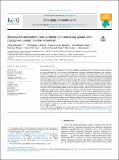Removal of lamivudine from synthetic solution using jamun seed (Syzygium cumini) biochar adsorbent

View/
Date
2023-09-01Author
Ripanda, Asha
Rwiza, Mwemezi
Nyanza, Elias
Bakari, Ramadhani
Bakari, Ramadhani
Miraji, Hossein
Njau, Karoli
Vuai, Said
Machunda, Revocatus
Metadata
Show full item recordAbstract
Antiviral drugs such as lamivudine have been globally identified in the environment and marked as emerging pollutants of concern due to their bioactive extremity. Following therapeutic uses, approximately 70% of the oral dose of lamivudine is eliminated renally as the parent drug. Concerns has been raised for neighbouring aquatic bodies due to effluent produced from production plants containing high concentrations of antiviral drugs. Antiviral drugs, such as lamivudine, are extremely bioactive, prompting interest in their urgent removal from the environment. The purpose of the present study was to optimize the removal of lamivudine from the synthetic solution using jamun seed (JS) (Syzygium cumini) biochar. The influence of sorption parameters such as pH, lamivudine concentration, adsorbent dosage, contact time, and calcination temperatures on the removal of lamivudine was investigated and optimized using a response surface methodology (SRM) based on optimal design. The results indicated that, a quadratic model best fits data with a model regression coefficient R2, adjusted R2, and predicted R2 of 0.9934, 0.9761 and 0.8340, respectively. The JS biochar calcined at 750 °C, at pH 8, initial lamivudine concentration of 10 ppm and contact time of 30 min indicated a maximum experimental removal efficiency of 84.9%. The residual standard error (RSE) value was 3.5% implying that the model was reliable. Isotherm data for the adsorption of lamivudine on JS biochar followed the Freundlich isotherm, with an R2 value of 0.9977 while R2 for the modified Langmuir model was 0.9852. These findings indicated that JS biochar is potentially useful for removal of lamivudine, and other organics from contaminated water and wastewater effluents. Therefore, this study presents an environmentally friendly remedy against lamivudine for a healthier ecology.
